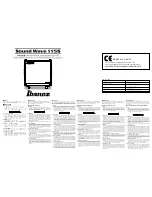
Version 1
19
Attenuator Transfer Curve
(SAMPLE DO NOT USE WITH YOUR INSTRUMENT)
In order to use this method, refer to the ATTENUATOR TRANSFER CURVE which is supplied for each
instrument There are two curves. Use the curve marked STETHOSCOPE MODULE.
On the curve, the vertical axis numbers indicate various SENSITIVITY levels, while the horizontal axis
displays DECIBELS. By following where the curve lines intersect on the chart it is possible to obtain decibel
changes from one reading to the next.
1. Use the basic procedure as described in the Comparative test (steps 1-7.)
2. Note, meter reading, and sensitivity selection on your Reference Chart. NOTE: in this method, the
meter reading is going to be your most consistent reading. For this reason, select a meter reading
that provides the majority of users comfort and ease when listening to the sound quality through the
headphones)
3. On subsequent readings, adjust the sensitivity dial until the meter reads exactly as noted in the
baseline reading.
4. Note the new sensitivity reading on the chart.
5. Refer to the Attenuator Transfer Curve and locate the decibel level for the current reading.
6. Note the decibel level for the baseline reading.
7. Subtract the original decibel reading from the current reading and you will have the decibel change
from the baseline reading to the present reading.
8. If this level exceeds 8 dB, it may indicate a lack of lubrication, if the reading exceeds 12 dB, it may
indicate the onset of the failure mode.
When using the ATTENUATOR TRANSFER CURVE method, there are three warning levels that have
been established. They vary somewhat from the SIMPLE method, but provide more information.
The three levels are:
a. 8 dB : Pre-Failure, Lack of Lubrication
b. 16 dB : Failure Stage
c. 35-50 dB: Catastrophic Failure
a.
Pre-Failure:
This is the earliest stage of failure. The
bearing may have developed hairline cracks or
microscopic spalls that are not visible to the human eye. This also signals a need to lubricate.
b.
Failure Stage:
At this stage, visible flaws develop
along with a marked rise in acoustic energy and the
temperature of the bearing begins to rise. It is at this stage that the bearing should be replaced or more
frequent monitoring should occur.
c.
Catastrophic Stage:
here, rapid failure is imminent.
The sound level is so intense as to be audible and the
temperature of the bearing has risen enough to overheat the bearing. This is a highly dangerous stage
since the bearing clearances increase and can cause additional friction/rubbing within a machine causing
potential damage to other components.















































